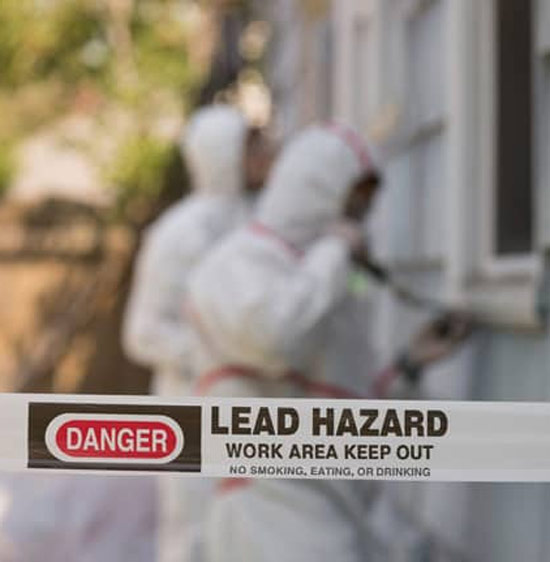NYC Lead Paint Removal Company-- Guaranteeing Safe and Lawful Compliance
Necessary Devices and Approaches for Reliable Lead Violation Cleaning
Attending to lead violations effectively necessitates a detailed strategy that blends the right tools with calculated methodologies. Simultaneously, the use of specialized clean-up devices, such as HEPA vacuum cleaners and lead-specific cleansing representatives, is essential for thorough contaminant removal. Effective containment methods, including plastic sheet and unfavorable air stress systems, are vital to stop the spread of unsafe materials.
Personal Protective Devices
Individual safety tools (PPE) is a critical component in the effective monitoring of lead contamination clean-up. The necessary PPE for lead cleanup consists of respirators, safety apparel, handwear covers, and eye security.
Respirators, specifically those furnished with HEPA filters, are indispensable for filtering air-borne lead particles, avoiding breathing. Protective apparel, consisting of coveralls and disposable fits, protects against lead dirt from sticking to workers' garments, lowering the risk of secondary contamination.
Moreover, extensive training on the proper usage and upkeep of PPE is crucial. Employees must be educated on donning and doffing procedures to prevent contamination. Regular examinations and substitutes of PPE parts are needed to maintain their safety abilities, making certain a secure and certified cleanup operation.
Specialized Cleaning Devices

An additional important device is the wet/dry vacuum cleaner, which can effectively tidy up both dust and liquid contaminants. These vacuum cleaners frequently include HEPA filters to provide an added layer of security. Wet wipes or tack fabrics are likewise important for surface cleaning; they are specifically made to catch and hold lead fragments, minimizing the risk of spreading contamination.
For even more stubborn deposits, specialized lead-removal cleaning agents are needed. These agents are developed to break down lead bits, making them less complicated to remove. Scrub brushes with sturdy bristles can assist in this procedure, particularly on rough surface areas where lead dust tends to adhere extra highly.
In addition, encapsulants are used to seal lead-contaminated surfaces, avoiding the release of lead dirt. These specialized paints and coatings are made to adhere to different substrates, giving a long-lasting remedy for lead control.
Effective Containment Methods
Effective control methods are important in reducing the spread of lead try here contamination during cleaning activities. Implementing durable control techniques ensures that lead fragments do not move to unaffected locations, thus safeguarding both employees and the environment (DOH & HPD Lead Violation Removal NYC).

To enhance control, encapsulants can be put on surfaces that are not being eliminated or interrupted. These specialized coatings bind lead dirt, minimizing its availability for resuspension. In addition, all employees need to use proper Personal Safety Devices (PPE), consisting of respirators and non reusable fits, to stop contamination spread.
Safe Disposal Practices
Making sure safe disposal techniques is a critical element in the management of lead contamination cleanup. Appropriate disposal minimizes the risk of lead returning to the atmosphere and jeopardizing public wellness. The very first step is to determine and segregate lead-contaminated waste from other products. Safe and secure containment using sturdy, watertight containers is vital to protect against spillage throughout transport.
Carrying lead waste calls for adherence to stringent standards. Making use of qualified contaminated materials carriers ensures that the products are handled responsibly. Documentation, consisting of materializes detailing the kind and quantity of waste, need to accompany deliveries to track the waste from the website of origin to its final disposal destination.
Designated dangerous waste disposal facilities are equipped to deal with lead-contaminated materials safely. These facilities typically utilize sophisticated techniques such as stablizing, solidification, or chemical therapy to counteract the lead before disposal. Landfilling in specialized, lined locations that stop leachate from contaminating groundwater is a typical method for final disposal.
Routine training for personnel associated with lead garbage disposal is vital to preserve safety standards and protect against unintentional direct exposure. By sticking to these techniques, organizations can considerably minimize the ecological and health impacts connected with lead contamination.
Regulatory Conformity Tips

Sticking to regulative conformity is vital in the effective implementation Click This Link of lead contamination clean-up. Understanding and adhering to government, state, and regional guidelines guarantees not just the safety and health of individuals however also the lawful and economic wellness of the cleanup company. The Epa (EPA) sets stringent standards, such as the Lead Remodelling, Repair Work, and Paint (RRP) Policy, which mandates correct accreditation and training for pop over to this site professionals dealing with lead-based activities.
Compliance starts with a thorough assessment of applicable legislations and policies. Organizations needs to stay upgraded on any legislative adjustments, which can be assisted in with normal training sessions and subscribing to industry updates. Paperwork is another critical compliance facet; keeping in-depth records of all tasks, consisting of inspection reports, staff member training logs, and disposal manifests, is vital.
In addition, involving with accredited lead assessors or risk assessors ensures that lead dangers are correctly determined and minimized. Companies have to apply using Individual Safety Tools (PPE) and make sure that security methods are purely followed. Finally, clear communication with stakeholders, including employees, clients, and governing bodies, will certainly foster a culture of conformity and responsibility, ultimately contributing to a much safer and much more effective lead cleaning procedure.
Conclusion
Effective lead infraction clean-up requires the assimilation of specialized devices and critical methods to make certain safety and efficacy. Personal protective devices (PPE) safeguards employees from direct exposure, while safe disposal methods and stringent adherence to regulative conformity are vital for properly managing harmful waste.